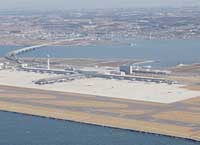|
|
|||||||
|
|
|||||||
|
|||||||
| | Web Japan >> | Trends in Japan >> | Business & Economy >> | Japan's Newest International Airport | |
|
JAPAN'S NEWEST INTERNATIONAL AIRPORT Centrair Offers Easy Access to Destinations Across Japan (March 25, 2005) Air travel to and from Japan became a lot more convenient on February 17. This day marked the opening of Central Japan International Airport, a wholly new facility built on a 580-hectare artificial island in the bay of Tokoname City, not far from the major city of Nagoya. The airport, nicknamed Centrair, is Japan's third major international air gateway, after Narita International Airport, which serves Tokyo and the surrounding area, and Kansai International Airport, which serves Osaka, Kyoto, and Kobe. Centrair is ideally situated for visitors to EXPO 2005, which will be held from March 25 to September 25 at a venue near Nagoya. Smooth Transit Unlike in the Kanto and Kansai regions, where passengers often have to transfer to a different airport to change from an international to a domestic flight, in Centrair's case nearly all of the flights previously handled by nearby Nagoya Airport have been transferred to the new facility. In fact, Centrair is served by far more domestic flights than either Narita or Kansai International. The airport's authorities hope that Centrair's extensive network of domestic flights will attract significant numbers of international passengers from all over Japan - from Hokkaido and the Tohoku region in the north to Shikoku and Kyushu in the south. Centrair also aims to grab a large chunk of the air cargo market. Flights carrying freight take off from Centrair round-the-clock under agreements with nine cargo airlines, including Nippon Cargo Airlines Co., making the airport an important cargo hub. Centrair will have no shortage of freight customers, as Central Japan is home to one of the country's biggest concentrations of manufacturing industries. Much of the cargo leaving Centrair consists of orders from automakers based in the region. Airport officials hope that about 50% of the region's cargo, or around 600,000 tons a year, will eventually pass through Centrair. A Bath with a View Thanks to the operator's emphasis on cost efficiency - as seen in the highly transparent manner in which it procured building materials - it managed to chop ¥124.9 billion ($1.18 billion at ¥105 to the dollar) from the originally estimated total construction costs of ¥768 billion ($7.31 billion). Another of Centrair's attractions is its commercial facilities. The airport's distinctive food court dominates the fourth floor of the passenger building. Western cuisine can be found at Brick Road, a recreation of a European town, while Korean and Chinese dishes are also available. Japanese food can be had at Chochin Dori ("lantern road"), which is modeled after a posting station of the Edo period (1603-1868). Restaurants resembling playhouses and other traditional buildings serve Japanese rice and noodle dishes. But the building's main attraction is the Tenbo Buro (bath with a view), a spa facility that offers views of airliners landing and taking off. In addition, there is an indoor garden facility that can be used for wedding ceremonies and banquets. Already more than 60 couples are booked to tie the knot on Centrair's premises - attracted perhaps by the ease with which they will be able to set off on their honeymoons. Commercial facilities at airports are often little more than places where passengers wait before boarding their flights. Centrair, however, intends to generate significant revenue by luring consumers - whether passengers or not - to spend some of their time and money at the airport. The airport's operator is hoping that as much as 60% of the facility's revenue will come from sources not directly related to airport operations, such as the designer boutiques located in the passenger building. This is just one of the fresh ideas that Centrair is bringing to Japan's airport sector. Copyright (c) 2005 Web Japan. Edited by Japan Echo Inc. based on domestic Japanese news sources. Articles presented here are offered for reference purposes and do not necessarily represent the policy or views of the Japanese Government. |
KYUSHU SHINKANSEN LINE (April 5, 2004) TRAINS VERSUS PLANES (November 20, 2003) |
|
|



